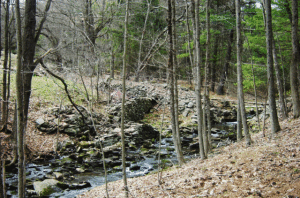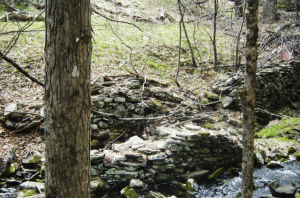



Five miles northwest of Halfway Brook Village was Beaver Brook (sometimes called Beaver Brook Mills), where James K. Gardner supervised a lumbering operation for St. John and Dodge.
James K., his wife Eliza Eldred, and their three children lived in the area in 1836.
Between Beaver Brook Mills and Halfway Brook Village, was Blind Pond, which had a brook of the same name. A mile or so southeast of Blind Pond was a sawmill powered by Blind Pond Brook.
Visible from the sawmill was a bunkhouse built by a lumber company (perhaps the nearby St. John-Dodge operation), as living quarters for the lumberjacks that worked for them.
Sherman B., or Buckley, as Sherman Buckley Leavenworth was called, was one of those lumberjacks. Buckley and his wife Charlotte Ingram were in Halfway Brook Village at least by 1835.
Charlotte, according to the family story, was the cook for the lumberjacks who lived in the bunkhouse.
The early bunkhouses for lumbermen were small with dirt floors. Their later living quarters were usually in a larger building.
The ground floor contained a room for the cook (who could be a woman, as in the case of my great-great-grandmother Charlotte Ingram Leavenworth), and a dining room. Meals were served on long board tables, and the crew were only allowed in the room at meal time. A “men’s room” was at the end of the room where the crew could relax, read, grind their axes, or tell stories in the evening.
A ladder went to the attic where there were tiers of bunks for sleeping. A one story log building was used as a barn for the horses and a storehouse for hay and oats.—The Mill on Halfway Brook, Chapter 5.
Source about Bunkhouses: Fox, William Freeman, “A History of the Lumber Industry in the State of New York,” published in the Sixth Annual Report of the New York Forest, Fish, and Game Commission, 1901.







